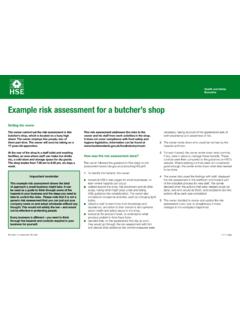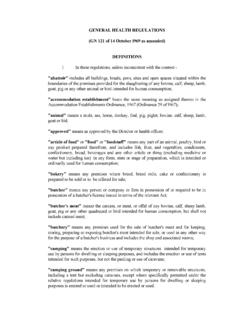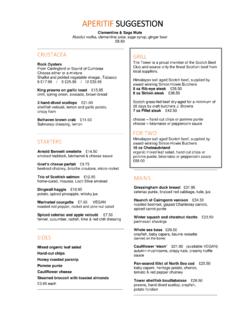Transcription of Work-related Musculoskeletal Disorders (WRMSDs) Statistics ...
1 This document is available from Page 1 of 22 Health and Safety Executive Work-related Musculoskeletal Disorders (WRMSDs) Statistics in Great Britain 2017 Summary 2 All Work-related Musculoskeletal Disorders 3 Working days lost 4 WRMSDs by industry and occupation 5 WRMSDs by age and gender 6 WRMSDs by workplace size 7 WRMSDs Back Disorders 9 Back Disorders by industry and occupation 10 Back Disorders by age and gender 11 Back Disorders by workplace size 12 Work Related Upper Limb Disorders (WRULDs) 14 WRULDs by industry and occupation 15 WRULDs by age and gender 16 WRULDs by workplace size 17 Work Related Lower Limb Disorders (WRLLDs) 19 This document is available from Page 2 of 22 Summary 507,000 Workers suffering from Work-related Musculoskeletal Disorders (new or long-standing) in 2016/17 million Working days lost due to Work-related Musculoskeletal Disorders in 2016/17 Musculoskeletal Disorders by affected area, 2016/17 Industries with higher than average rates of Musculoskeletal Disorders , averaged 2014/15-2016/17 * Rate based on fewer than 30 sample cases Musculoskeletal Disorders per 100,000 workers: new and long-standing Source.
2 Labour Force Survey (estimates of self-reported Musculoskeletal Disorders caused or made worse by work) This document is available from Page 3 of 22 All Work-related Musculoskeletal Disorders Work-related Musculoskeletal Disorders (WRMSDs) can be sub divided into the more specific and recognised body regions of the back, upper limbs and lower limb Disorders . These sub categories when combined, form the overall grouping values presented in this document for the general classification of MSD illness type. Musculoskeletal Disorders can affect muscles, joints and tendons in all parts of the body. Most WRMSDs develop over time. They can be episodic or chronic in duration and can also result from injury sustained in a Work-related accident. Additionally they can progress from mild to severe Disorders .
3 These Disorders are seldom life threatening but they impair the quality of life of a large proportion of the adult population. Work-related Disorders can develop in an occupational setting due to the physical tasks with which individuals carry out their normal work activities. WRMSDs are associated with work patterns that include: Fixed or constrained body positions Continual repetition of movements Force concentrated on small parts of the body such as the hand or wrist A pace of work that does not allow sufficient recovery between movements Additionally workplace psychosocial factors such as organisational culture, the health and safety climate and human factors may create the conditions for WRMSDs to occur. Generally, none of these factors acts separately to cause WRMSDs.
4 They more commonly occur as a result of a combination and interaction among them. However to date WRMSDs in Great Britain remains an ill health related condition that places significant burdens on employers and employees accounting for 39% of all Work-related ill-health. The rest of this document looks in more detail at the Statistics related to WRMSDs to get a clearer understanding of the problem within the working environment in Great Britain. This document cites two main sources for WRMSD Statistics . The first is the Labour Force Survey (LFS), an annual survey of 37,000 households in Great Britain. The second is analysis from a survey of occupationally trained General Practitioners across Great Britain called, The health and occupation network of general practitioners (THOR-GP).
5 The latest estimates from the Labour Force Survey show that in Great Britain: The total number of WRMSDs cases (prevalence) in 2016/17 was 507,000 out of a total of 1,299,000 for all Work-related illnesses, 39% of the total and a rate of 1,550 cases per 100,000 workers. The rate is not statistically significantly different from the previous year. The rate of total self-reported Work-related Musculoskeletal Disorders showed a generally downward trend. The number of new cases of WRMSDs (incidence) in 2016/17 was 159,000, an incidence rate of 480 cases per 100,000 workers. This rate is not statistically significantly different from the previous year. An estimated million working days were lost due to WRMSDs in 2016/17, an average of days lost for each case.
6 This is not statistically significantly different from the previous year. Work-related Musculoskeletal Disorders account for 35% of all working days lost due to Work-related ill health. Working days lost per worker due to self-reported Work-related Musculoskeletal Disorders showed a generally downward trend up to around 2010/11; since then the rate has remained broadly flat. This document is available from Page 4 of 22 Figure 1. Estimated prevalence and incidence rates of self-reported WRMSDs in Great Britain, for people working in the last 12 months, 2006/07-2016/17 Working days lost An estimated million working days were lost due to WRMSDs, an average of days lost for each case. WRMSDs represent 35% of all days lost due to Work-related ill health in Great Britain in 2016/17.
7 Within the total number of million days lost due to WRMSDs, Work Related Upper Limb Disorders (WRULDs) account for around 44% of days lost, with back Disorders around 36% and Work Related Lower Limb Disorders (WRLLDs) 20%. Figure 2. Estimated days lost (full-day equivalent) due to self-reported WRMSDs in Great Britain, for people working in the last 12 months, 2006/07-2016/17 This document is available from Page 5 of 22 WRMSDs by industry and occupation The industries with the highest rates of WRMSDs averaged over the 3 year period 2014/15-2016/17 are Agriculture, forestry and fishing, Construction, Transportation and storage and Human health and social work activities. Compared with the average rate for all industry these industries have statistically significantly higher rates of WRMSDs.
8 Looking more closely at these industry areas, the following sectors are those with the highest rates of WRMSDs. (Figure 3) Within the agricultural industry it has been consistently shown that WRMSDs are the most common of all occupational non-fatal injuries and illnesses for farm workers, especially those who are involved in labour-intensive practices (McCurdy et al., 2003, Meyers et al., 1997, Villarejo, 1998 and Villarejo and Baron, 1999). Whilst, agriculture in Great Britain is highly mechanised and not as labour intensive as other countries agricultural workers are still at risk from WRMSDS. These include: lifting and carrying heavy loads (over 50 lb); sustained or repeated full body bending (stoop); and very highly repetitive hand work (clipping, cutting).
9 Historically workers in the postal industry have reported higher rates of WRMSDs due to lifting and carrying mail sacks. Industrial automation of tasks has reduced the scope over the years, however, a recent report in the USA by the National Institute for Occupational Safety and Health (NIOSH) has suggested that investigators have identified excessive heavy lifting and several ergonomic hazards -- design features that tax or endanger the human body excessively - associated with the Postal Services automated mail-processing equipment. The agency warns that these hazards put employees at potential risk for crippling low back problems as well as Musculoskeletal Disorders of the upper body; other NIOSH studies have found that machine-paced postal workers reported a higher incidence of fatigue, blurred vision, and neck, arm, or hand complaints.
10 In the UK, the main postal workers union, the Communication Workers Union (CWU) suggested that postal workers representing of the UK workforce reported 10% of WRMSDs (Hooper 2015) Figure 3. Estimated prevalence rates of self-reported WRMSDs in Great Britain, for people working in the last 12 months, by selected industries, averaged 2014/15-2016/17 Within the category of Human health and social work activities, there is a higher risk of WRMSDs. Most attention has been directed towards nursing in terms of mitigation of risks associated with WRMSDs. However, the health care sector employs a large range of occupations, including paramedics, care assistants, theatre support staff, maintenance, food services, and cleaning staff (Hignett, Fray, et al.)















